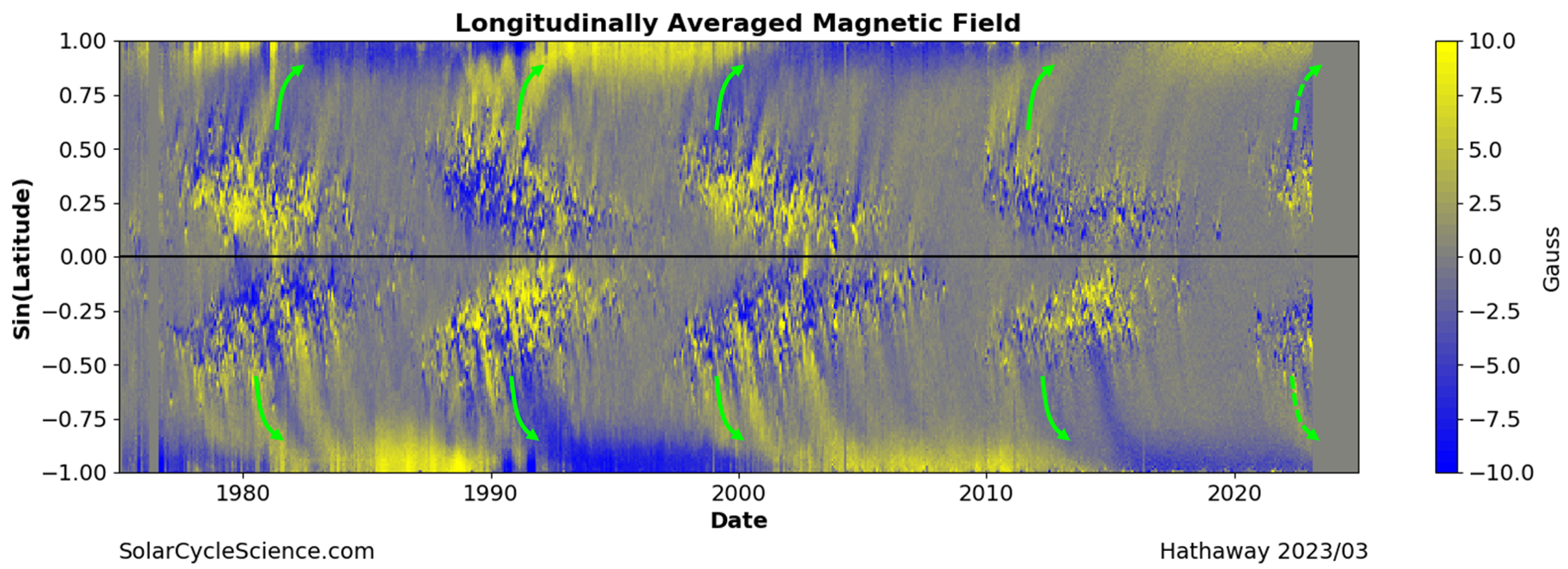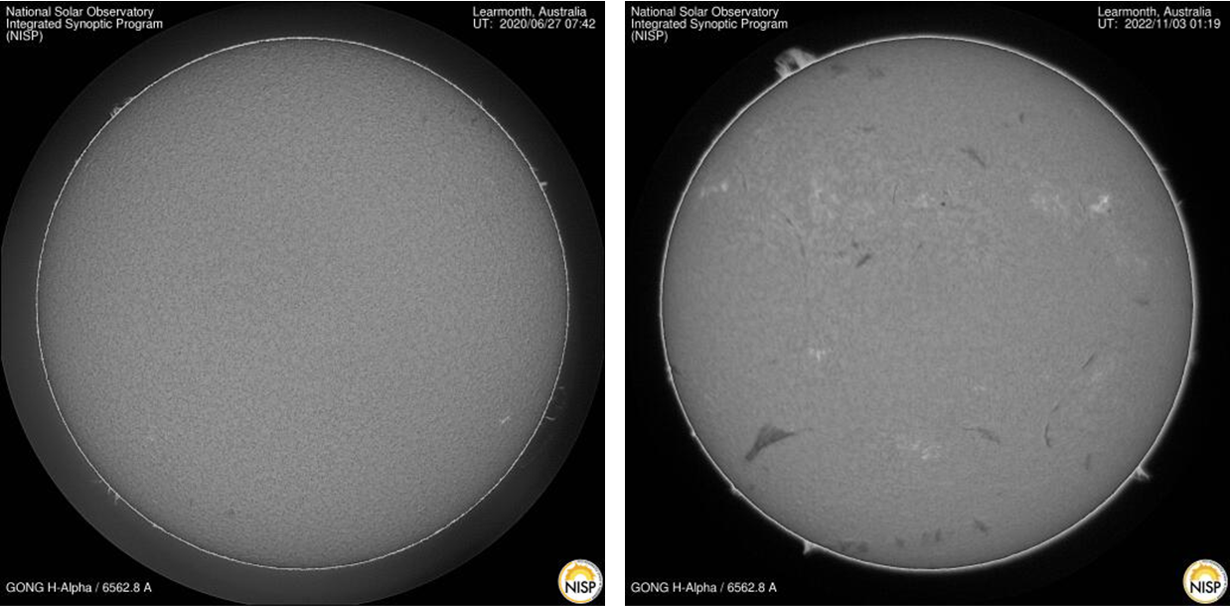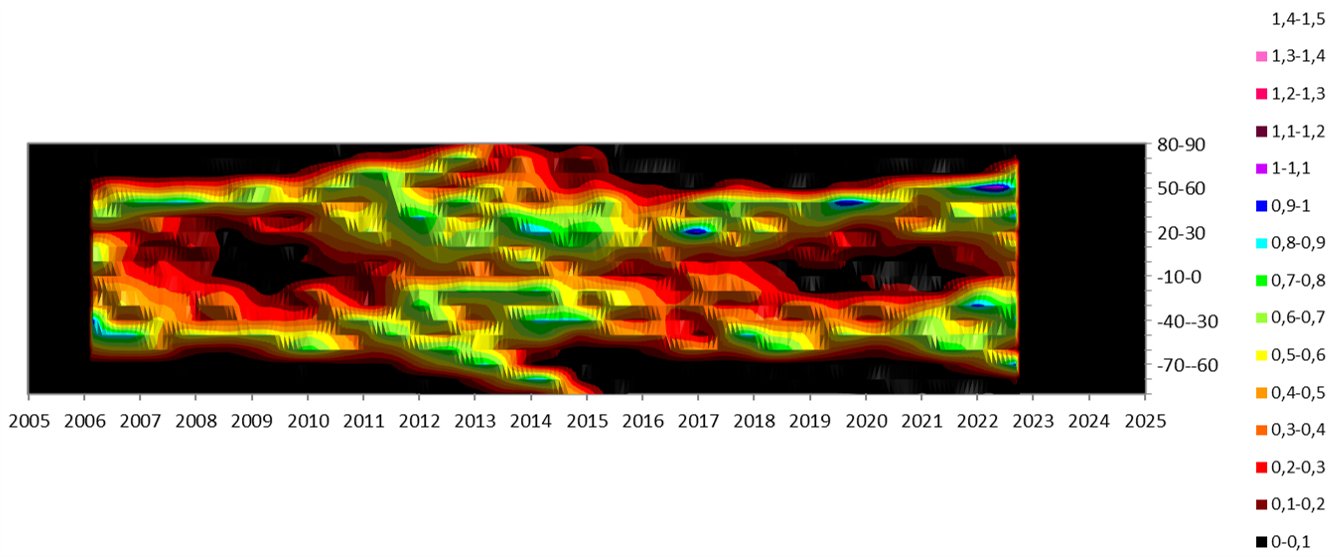Each solar cycle, during the period of maximum activity, the magnetic field at the solar poles disappears and gets replaced by a magnetic field of opposite polarity. These reversals are a key feature of the solar dynamo: the physical process that generates the Sun's magnetic field necessary for the creation of sunspots and other magnetic phenomena. This switch of the polar magnetic fields does not take place overnight. Indeed, it may take even several months before they are permanently established. The old polar field is replaced by opposite polarity field from the magnetic remnants of active regions, being transported towards the poles by the Sun's magnetic conveyor belt, as tree leaves floating on a rippling creek. This is a slow process as can be seen in the figure underneath from the SolarCycleScience page, annotated by green arrows indicating the movement from the active region belt towards the solar poles (yellow is positive polarity, blue negative). This reversal can take place at different times for the poles, and may also be of different duration. For example, during the previous solar cycle, the polar field reversal at the southern pole was completed in just a few months around mid-2013, whereas for the northern pole the reversal started around mid-2012 and was only completed late 2014 (Mierla et al. 2020).

Solar filaments are clouds of charged particles ("plasma") above the solar surface squeezed between magnetic regions of opposite polarity. Being cooler and denser than the plasma underneath and their surroundings, they appear as dark lines when seen on the solar disk and as bright blobs when seen near the solar limb (then they are called "prominences"). Special filters are required to observe these features, and one such a filter is the Hydrogen-alpha line in the red part of the solar spectrum (H-alpha; 656,3 nm). Contrary to the sunspot groups which are mostly visible between solar latitudes +30 and -30 degrees, filaments and prominences can basically occur all over the surface, as long as there are opposite polarity magnetic fields which are strong enough to allow for these features. The H-alpha images underneath show filaments and prominences observed in mid-2020 (left) and late 2022 (right), as observed by the GONG network.

So, it is not a surprize that, aside the filaments present in the main zone between latitudes of about +50 and -50 degrees, one can also observe a movement in the filaments towards the poles during the ascending phase of the solar cycle, when the dispersed magnetic remnants of decayed active regions move poleward and interact with the existing, opposite polarity magnetic fields near the Sun's poles. This "rush-to-the-poles" is well known and also observed in e.g. coronal emissions at a wavelength of 530,3 nm (e.g. Altrock 2011). It can also be observed with modest H-alpha telescopes. The graph underneath was compiled from observations made with a small 4-cm H-alpha telescope starting mid-2005. It shows per latitude bin of 10 degrees (vertical axis) the smoothed monthly number of prominences (colored). The rush-to-the-poles during the previous solar cycle can easily be distinguished, and one can deduce from the most recent observations that this poleward movement is currently in progress, with prominence numbers that are a little bit higher than during the previous solar cycle (resp. blue-pink vs green-blue).

Polar crown filaments are located at the highest latitudes, thus separating the predominant polar field of the previous cycle and the dispersed field of the current cycle, drifting poleward from the trailing polarities of sunspot groups in lower latitudes. The poleward migration is an important property of polar crown filaments and a good indicator of the polarity reversal of the solar magnetic field and the occurrence of the solar maximum (Xu et al. 2021). Currently, these polar crown filaments are still a bit chunky and not well formed. They can however become very pronounced and long, up to at least 200.000 km. Because of their length, they can -just as any other long filament- become unstable and erupt, such as e.g. in June 1999 (see the Yohkoh Science nugget). Dynamic magnetic interactions between these filament chunks can occur at all time, as reported in this STCE newsitem and the related YouTube movie.


So it was a bit surprizing that media (Tamitha Skov, Space.com, Yahoo!News, and many more) reported about a "solar polar vortex" that had been observed on the Sun's north pole on 2 and 3 February. The claims were based on SDO/AIA 304 imagery (movie above top), showing what apparently looked like a whirlwind flowing over the polar crown filament all around the north pole itself at astounding speeds of nearly 100 km/s. However, some caution is certainly warranted when drawing this conclusion, in particular when one examines the area at higher temperatures (SDO/AIA 193 ; movie above bottom), where the "cold" plasma is now visible as dark strands against the bright and hot solar upper atmosphere. Indeed, the SDO/AIA 193 movie shows that the reported vortex just seems to concern interactions between the various, both nearby and faraway, portions of the polar crown filament, very much to what has been reported in the 2012 STCE newsitem above. Material seems to move from east to west as well as from west to east, the apparent "vortex" movement fortified by the waving of the rotating filament chuncks, as trees bending during a violent storm. A further critical examination was given by Dr Keith Strong from the University of Maryland, available in his YouTube video. Whatever may be the right interpretation, this kind of discussions will soon come to an end as Solar Orbiter is gradually changing its ecliptic orbit (in the Sun-Earth plane) around the Sun to a more inclined one, thus giving solar physicists a much better view on the Sun's poles and hopefully contributing in solving the mystery of the solar dynamo and the rise and fall of the solar cycle.






